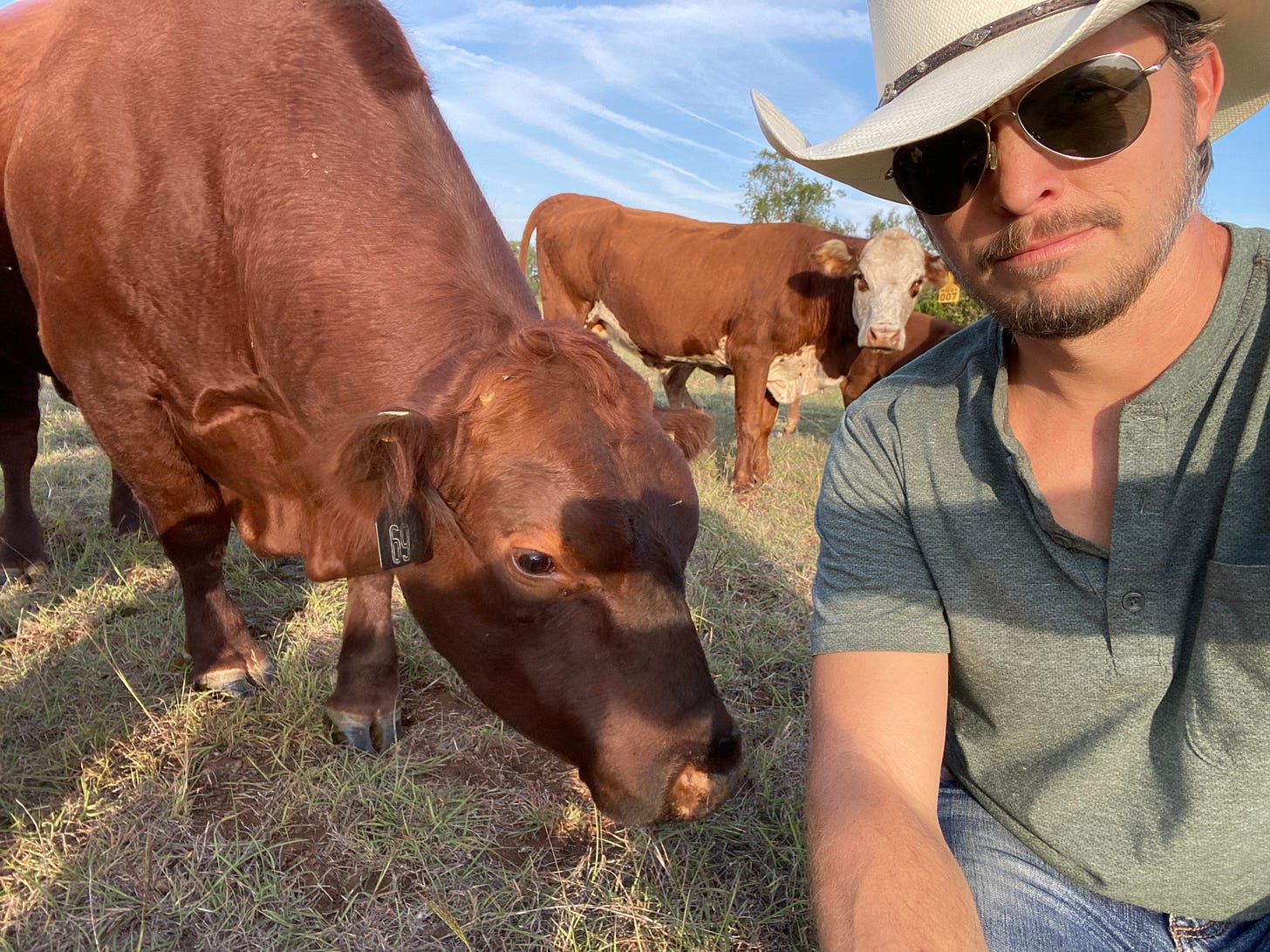Howdy Beef Eaters,
My name is Dustin Hammit. I raise beef, sell real estate (read about it at theDirt.substack.com), ask a lot of questions, and write a lot of words. This is the newsletter for Legacy H Cattle Company. We raise grass-fed, all-natural, no-chemical, no-hormone, - No bull, just theBeef - on the RU Ranch in Liberty Hill, Texas. In this inaugural edition of theBeef newsletter, I pose the question: what is the true cost of cheap meat?
Sticker shock
We consumers (Your Humble Author included) often pay a great deal of attention to the sticker price of an item. All we want to know is exactly how much we are going to spend. To most of us that is the full cost, and we don’t put much thought beyond that. Been there, done that. I get it.
But there are costs beyond the sticker. In a new era of extraordinary inflation you should begin to wonder (I’m sure you have already) exactly what you get for your hard earned dollar. When you pay $5 per pound for the bottom barrel meat at the grocery store, what do you purchase? Well, you get one pound of ground meat from any number of cattle raised in any number of ways and juiced with any number of designer chemical compounds before they were slaughtered en masse and thrown together in a big grinder. Bon appetite!
In that pound of meat you might be eating the meat from a sick, old cow nursed along until she is squeezed into the slaughter chute. You might be eating low-quality meat grown in Brazil and shipped all the way to the US. You might be eating the remains of a Franken-steer genetically selected to grow to over 1,000lbs in under two years (rated “Prime” of course). My fellow beef eaters, when you buy a one pound pack of the cheap stuff, you are not only buying the meat, but you are also buying into a ‘food’ system designed to sell you the cheapest meat grown as quickly as possible and for the most money possible. They (the big meat packers) do not care about quality beyond meeting USDA and FDA regulations.
And do you know what you are probably NOT buying? Nutrients. That’s right, honest to God nutrition; those chemical compounds absolutely necessary for our bodies to function the way God intended. Ladies and gents, for $5 you might be getting a pound of cheap meat but how much nutrition is in that meat?
Amino acids aren’t talked about as much as vitamins and minerals, so it’s cool to know what some of these guys do. Tryptophan, for example, is a precursor for serotonin, so if you’re deficient you can suffer from immense depression or insomnia. You need phenylalanine to produce tyrosine which act as the building blocks for thyroid hormones and dopamine. Taurine is the building block for bile, allowing us to digest and assimilate fat. If you don’t have taurine you won’t be able to absorb all those incredible omega-3’s…
Anything worth doing takes time and effort
According to a standard French handbook, Technologie Culinaire (1995), the meat of an animal less than two years old is “completely insipid,” while meat “at the summit of quality” comes from a steer three to four years old.
On Food and Cooking, The Science and Lore of The Kitchen by Harold McGee
Life is a game of trade-offs, and you just can’t rush physics. Modern genetics and technology give the illusion of defying gravity but of late we are learning that we cannot, in fact, have our beef and eat it too. The ‘miracle’ that is the modern food industrial complex comes at a cost. And that cost is nutrition.
…early studies of fertilization found inverse relationships between crop yield and mineral concentrations—the widely cited “dilution effect”; 2) three recent studies of historical food composition data found apparent median declines of 5% to 40% or more in some minerals in groups of vegetables and perhaps fruits; one study also evaluated vitamins and protein with similar results; and 3) recent side-by-side plantings of low- and high-yield cultivars of broccoli and grains found consistently negative correlations between yield and concentrations of minerals and protein, a newly recognized genetic dilution effect.
American Socitey for Horticultural Science: Nutrient Declines in Historical Food Composition Data:
Our modern “food” system might raise a 75-lbs calf to a 1,200-lbs steer in under two years, but is that natural? A wild bovine in an unforced environment (versus a stuff-food-in-its-gut-like-goose-pate feed lot) takes at least three years to reach that weight. So what price do we pay to the law of physics to achieve that efficiency? My fellow Beef Eaters, I submit that you sacrifice actual nutrition. You sacrifice vitamins and minerals. You sacrifice amino acids and Omega-3s. You sacrifice all the good stuff and replace it with… water and whatever other industrial waste can accumulate in fat cells in such a short amount of time.
Frontiers in Nutrition: Priority Micronutrient Density Foods
Production beef versus Custom Beef
Consider the following: would you buy a house that was built in a single day? I know that I wouldn’t. Most people understand that it takes effort and time to build a structurally sound house. The faster a house is completed, the more questionable its quality. What corners did the builder cut to get that house done in a day? What shortcuts were taken? Ask anyone who has purchased a production home in the past few years what kind of quality they received versus someone who waited a while for a custom home to be built. The reported differences in quality should not surprise. Folks, you get what you pay for! Why would we expect a different result when we grow a calf from an embryo all the way to a 1,000-plus pound animal in under two years? Well you shouldn’t. Because bio-physics.
I pose again the $12 question: what do you get when you buy $5 worth of cheap meat? You get beef raised in a system designed to make as much meat as fast as possible and as cheaply as possible. You get a house built in a day.
The industrial food complex is composed of profit-maximizing corporations that DO NOT CARE ABOUT YOUR NUTRITION OR HEALTH!! They care about maximizing profit and shareholder value.
What do you get when you buy one pound of awesome beef for $12 from Legacy H Cattle Company? Oh buddy! You get the beef from a single animal raised with its family herd over the course of at least 30 months (and frankly I think that is not enough time). You get the beef from an animal that was grown slowly and with care. You get the beef of an animal that eats what cows are supposed to eat: grass. And all of that extra time and care give you a product that has had the necessary days on this earth to acquire within its cells an abundance of actual nutrition. Best of all, you get a product from an individual that cares about your health like he cares about his own. Because guess what? I eat the exact same product and feed it to my family. How’s that for quality assurance?
Between a rock and a hard place
For any of my cattle raising brethren who might happen to read this: I know that this essay might make you mad. But these words are not a dig at you (most of you anyway). This essay is, however, a dig at a system built on faulty foundations. Beef Eaters, my fellow ranchers have been chained to a system designed to make cheap meat. They do the best they can within a system designed for them to fail - it wasn’t the gold miners making money in the gold rush but the companies selling them shovels. But of the cattlemen (and women) that I know personally, each raise their animals the best they know how. I imagine that most traditional ranchers out there care about their animals just as much as I care for mine. And they probably don’t make a whole lot of money in the process. They do it for the love of it and not for the profit. So do I (ain’t nobody gettin’ rich off cows over here, I promise you).
I must also write and insist that we cannot do away with cheap meat (or food) any more than we can do away with cheap houses. Not right away. Our entire world population was built on this system, faulty as it is. We can’t knock it down in a day. That is not my aim. That is not my goal. My goal is to educate and inform. Dear reader, my aim is to offer those who want to get the absolute most for their dollar a product which will meat (sic) expectations and give the most nutrients for the buck spent. All the rest will take good, old-fashioned time. Rome wasn’t built in a day. Neither is good beef.
Why you should subscribe to this newsletter (and why you should not)
You should subscribe to this newsletter if:
You jive with everything I wrote above
You care about what you put into your body
You believe that Food is Medicine!
You eat beef
You want the maximum nutrition for your dollar
You live in the central Texas area and want to be informed when there is all-natural, wholesome, nutrient dense, raised-on-the-ranch grass-fed beef available
You want to know the person who grows your food
You should not subscribe to this newsletter if:
You don’t care about your food or its quality
You don’t eat beef
You like and are comfortable with the Meat Industrial Complex
You don’t care about who grows your food
You have a bad attitude
Your Humble Author (the one on the right)
My name is Dustin Hammit. I raise beef cattle and questions. I produce protein and lots of words. I’m a grass farmer and bookstore cowboy. Most of my cattle brethren look at me sideways and wonder, who’s this rookie think he is? Fine by me. I am not the scion of an ancient ranching family, and I’m not beholden to tradition or ‘this is the way we’ve always done it’. I don’t care about any of that. I want to raise beef the best way possible and based on all of the information that is found on the ragged edge of the fringe - that place where all discovery is made and where change occurs. My fellow Beef Eaters, there is a food revolution afoot. And I am happy to be a part of it. Will you join me?







